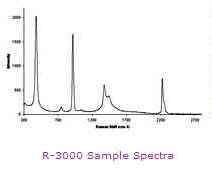
|
Raman Systems R-3000 Spectrometer
Features
Integrated System. All-in-one system includes diode laser, CCD-array
spectrometer, fiber optic probe and operating software
Improved Design. Third-generation instrument delivers gains in laser resolution
(better than 10 cm-1, compared with 15 cm-1 with the R-2001) and stability
(better than 1 cm-1 wavelength stability and 4% output stability)
Probe Flexibility. Fiber optic probe comes with accessory “caps” for simple
calibration and focusing
Software Improvements. New software features include fingerprinting and
quantification capabilities
Fully Integrated System
The Raman Systems R-3000 comes with a choice of 785 nm
or 532 nm solid-state diode laser; a fiber optic spectrometer with optional TE
cooling; an "all-in-one" fiber optic probe for liquids, solids and powders; focusing
and calibration caps; a software-controlled laser shutter and operating software;
a sample holder; and safety goggles.
 |
New software features include fingerprinting and quantification
capabilities (matching spectra to those stored in a database and determining the
concentrations of constituents from models/cal-sets), integration times may be increased
to several minutes, and a multiple -spectrum display function
(overlays of up to 20 spectra are possible).
|
Cooled Optical Bench
The R-3000 is available with an optional
thermoelectrically cooled CCD array, which allows integration times
of up to 4 minutes. The CCD is maintained at a constant temperature,
eliminating the need for dark current recalculation -- an advantage for
applications where turning the laser off and on to take dark scans is impractical.
Solid-state Laser
The R-3000 uses a 500 mW 785 nm (red) solid-state diode
laser that is stable enough for use with focused probes -- for measurements
through containers and windows -- and that has a wavelength range of
~200-2700 cm-1. Also available are 25 mW and 50 mW versions of a 532 nm laser,
which has a wavelength range of ~200-4000 cm-1.
Fiber Optic Probe with Accessory Caps
The R-3000 comes with a fiber optic probe, sample
tubes and probe "caps" -- accessories that provide easy transferability
between samples (solids, tablets, powders and the like) in transparent
containers. The probe head containing the optics is coupled to the spectrometer
and laser via two fibers (200 µm and 100 µm in diameter). The standard fiber
length is 1 meter; however, various fiber lengths are available, from 1 meter-200 meters,
which allow the user the flexibility of keeping the spectrometer close to the sample or at a
distance. Fibers are protected with either PVC monocoil or stainless steel sheathing.
The stainless steel sampling tube is 3.5 inches long and 1/2 inch in diameter. Other tube
lengths are available and can be up to 10 inches long; the tubes are easily interchangeable
for different applications. There are two focusing caps: one focuses the laser beam on solid
samples as the cap is pressed against the sample while the other focuses the laser on the
inside of transparent containers containing powders, liquids or gels when the cap is pressed
against the outside wall of the container.
Additionally, there is a cap for the instrument's calibration; this is a pre-loaded
spectroscopic standard that allows for quick, software-controlled instrument calibration
and verification. For corrosive environments, custom-built tubes and caps can be made
from Hastelloy-C. The tube and caps will normally withstand up to 1500 psi and up to 200 ºC;
however, they can be made to withstand up to 3000 psi and up to 500 ºC. Please note that the
standard provided probe head and fiber cable will withstand only up to 80 ºC.
Immersion probes can also be ordered as custom items; detailed application parameters are
needed to design and quote these probes.
For added eye safety, the probe contains a software-controlled shutter that is normally
closed and opens only when a measurement is being taken. The shutter allows dark scans
to be taken without turning the laser on and off.
Probe Available for Individual Sale
This probe (RAM-PR-S) is also available individually for
those who are configuring their own Raman system using the RSI-LASER-532 or
RSI-LASER-785 along with an Ocean Optics spectrometer. The standard fiber length
is 1 meter, but longer fibers (up to 5 meters) are available at no extra cost.
The working distance (the focal length of the lens at the end of the tube, before
attachment of the caps) of the probe is 4.5 mm, with 1 mm to 22 mm available
(specify at time of purchase). Two focusing caps are included, an S cap for
solid surface measurements and an L cap for measurement of liquids through vials.
When used with a modular Raman system (not the R3000), adjustment of the laser power may be necessary
since there is about a 50% attenuation when the laser hits the sample. For some applications,
this is too much laser power, resulting in degradation of the analyte's chemistry, and resulting
in bad spectra. The R3000 systems include a calibrated dial for adjusting laser power, and while
the RSI-LASER models have a potentiometer for laser adjustment, it is not calibrated. You will need
to use a laser power meter such as the one offered by GentecEO to adjust the laser to a safe power level.
Safety Advisory
The laser beam emerging from the R-3000 laser output port
or from the fiber optic probe is a Class 3b laser. This laser product produces visible
and/or invisible laser radiation. It is capable of causing serious eye injury and blindness
to anyone who looks directly into the beam or its specular reflections. Laser safety eyewear
must be worn at all times while operating the R-3000.
Contact
us for more information.

|

|